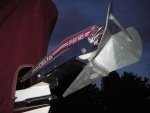To expand on the excellent advice of Foggy, let the boat break the anchor out--that is the key, both with and without a windlass. You can drive the boat up to, or even a little beyond where the anchor was dropped, and then you are just brining up line, and not pulling the boat as you bring the anchor rode in. You can do this several times if necessary. Be sure you don't foul the prop!!
When working without a windlass, you may be best served by putting the anchor rode in either a milk type plastic crate, or a tub. Trying to feed the line thru the deck pipe when pulling can be very time consuming. The tub or crate cane be secured to the foredeck. Another option is to just coil the line on the deck, secure it and let it dry before feeding thru the deck pipe to the anchor locker.
I first fitted a windlass to a boat in 1980. For over 30 years, I had raced sailboats up to 45 feet in length without a windlass--only "arm strong"--great for the arms, and very bad for the back!!!! Please be very careful about posture, and how you apply forces to bring the anchor rode up. There is actually a very good reason to stand on the berth and pull the anchor up--you can stand with a straight back! If you pull from the foredeck, use your legs. Advice not only as a physician, but as a patient!
For the last 38 years every boat I have owned had a windlass--the $700 for a windless is pennies in comparison to the tens of thousands in medical bills!!!

